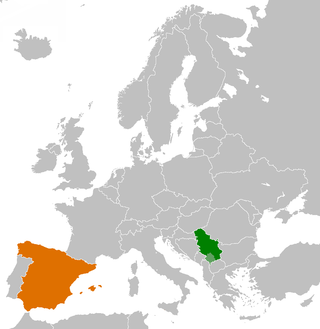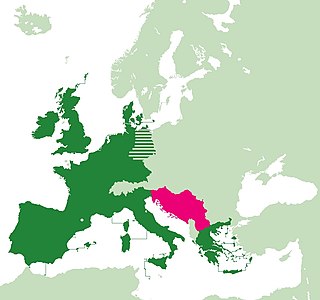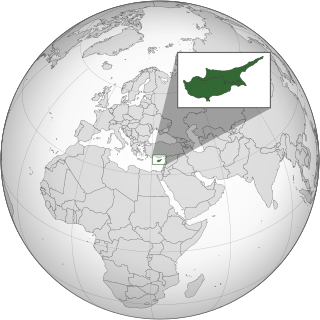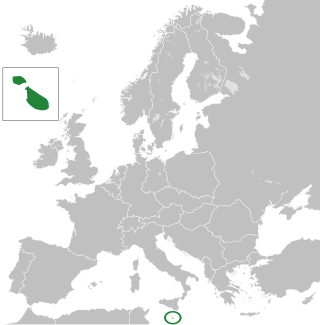
Janez Drnovšek was a Slovenian liberal politician, President of the Presidency of Yugoslavia (1989–1990), Prime Minister of Slovenia and President of Slovenia (2002–2007).

The accession of Croatia to NATO took place in 2009. The country entered into Partnership for Peace in 2000, which began the process of accession into the alliance. It received an invitation to join at the 2008 Bucharest summit and became a full member on April 1, 2009.

Serbian-Spanish relations are foreign relations between Serbia and Spain. Both countries established diplomatic relations on October 14, 1916. Serbia has an embassy in Madrid. Spain has an embassy in Belgrade. Both countries are member states of the United Nations, Interpol, Council of Europe and Organization for Security and Co-operation in Europe. Spain is member state of the European Union since 1986 and Serbia is a candidate country since 2012 negotiating its future membership which Spain is strongly supporting. Spain is member state of NATO alliance while Serbia is a militarily neutral country with strong historical relations with the Non-Aligned Movement. In relation to third parties, both countries supported position of Argentina in its Falkland Islands sovereignty dispute with the United Kingdom in the past.

Budimir Lončar is a Croatian retired politician and diplomat who served as a Minister of Foreign Affairs of SFR Yugoslavia from 1987 until 1991.

From the establishment of the European Economic Community in 1957 until the breakup of Yugoslavia in the early 1990s, thus during the Cold War period, the Socialist Federal Republic of Yugoslavia was the first socialist state to develop relations with the organisation. Notwithstanding occasional and informal proposals coming from both sides, Yugoslavia never became a full member state of the EEC.

The Socialist Federal Republic of Yugoslavia was one of the founding members of the Non-Aligned Movement. Its capital, Belgrade, was the host of the First Summit of the Non-Aligned Movement in early September 1961. The city also hosted the Ninth Summit in September 1989.

Cyprus–Yugoslavia relations were historical foreign relations between Cyprus and now split-up Socialist Federal Republic of Yugoslavia. Together with Malta, both countries belonged to the small group of European and Mediterranean member states of the Non-Aligned Movement during the Cold War, group which itself part of the larger group of neutral and non-aligned European countries. Two countries shared similar or identical views on many international issues and cooperated closely in the United Nations and at various gatherings of the non-aligned countries. Makarios III participated in the 1961 Summit Conference of Heads of State or Government of the Non-Aligned Movement in Belgrade which was the first official conference of the Non-Aligned Movement.

Finland–Yugoslavia relations were historical foreign relations between Finland and now split-up Kingdom of Yugoslavia or Socialist Federal Republic of Yugoslavia. Both countries gained their independence during or in the immediate aftermath of the World War I and the collapse of Austria-Hungary (Yugoslavia) or Russian Empire (Finland). Two parties established formal bilateral relations in 1928. Two countries developed their relations after the end of the World War II and 1948 Tito–Stalin split. At the time neither one of them was a part of either Eastern or Western Bloc in the Cold War divided Europe. Both countries perceived development of relations among non-bloc neutral European states as a way to avoid isolation and preserve certain level of independence without alienating major powers. Belgrade however perceived that in deeply divided Europe there was shrinking maneuvering space for neutral countries and followed the development of what will be called process of Finlandization with great concern. It therefore turned its focus on new allies among former colonies and mandate territories outside of Europe where it developed its policy of equidistant active neutrality via its activities in the newly founded Non-Aligned Movement.

Malta–Yugoslavia relations were historical foreign relations between Malta and now split-up Socialist Federal Republic of Yugoslavia. Together with Cyprus, both countries belonged to the small group of European and Mediterranean member states of the Non-Aligned Movement during the Cold War, group which itself part of the larger group of neutral and non-aligned European countries. The Non-aligned countries in Europe advocated for relaxation of divisions, rejection of superpowers' spheres of influence and for cooperation of diverse countries on the continent. During the Cold War period all three Non-Aligned Euro-Mediterranean countries developed close economic cooperation with the European Economic Community.

Summit Conference of Heads of State or Government of the Non-Aligned Movement on 1–6 September 1961 in Belgrade, Yugoslavia was the first conference of the Non-Aligned Movement. A major contributing factor to the organization of the conference was the process of decolonization of a number of African countries in the 1960s. Some therefore called it the ″Third World's Yalta″ in reference to 1945 Yalta Conference.

Third Conference of the Non-Aligned Movement on 8–10 September 1970 in Lusaka, Zambia was the third conference of the Non-Aligned Movement. A preparatory meeting of Foreign Ministers drafted a number of resolutions which were considered by the Summit Conference. President of Zambia Kenneth Kaunda opened the conference by underlining non-alignment as "the natural choice at the time of increased hostility created by ideological conflicts in the bipolar world"

The Non-Aligned Movement (NAM) is a forum of 120 countries that are not formally aligned with or against any major power bloc. It was founded with the view to advancing interests of developing countries in the context of Cold War confrontation. After the United Nations, it is the largest grouping of states worldwide.
50th Anniversary Additional Commemorative Non-Aligned Meeting was the 5–6 September 2011 Non-Aligned Movement foreign ministers commemorative meeting which took place in Belgrade, Serbia. The meeting took place in the House of the National Assembly of the Republic of Serbia, building which hosted the 1st Summit of the Non-Aligned Movement on 5–12 June 1961 during the existence of the Socialist Federal Republic of Yugoslavia. The idea for meeting was proposed by the President of Serbia Boris Tadić during his participation at 15th Summit of the Non-Aligned Movement in Sharm el-Sheikh in Egypt. Some 600 delegates, representing over 100 national delegations, attended the meeting.

1988 Non-Aligned Foreign Ministers Conference was held in Nicosia, capital of Cyprus in September 1988. 92 foreign ministers participating in the conference discussed United States and the Soviet Union rapprochement, South Africa's occupation of Namibia and Israel's occupation of Palestine, threats against Nicaragua, apartheid and the solution of the conflict in South-West Africa. During the conference, Socialist Federal Republic of Yugoslavia was unanimously selected as a host of the 9th Summit of the Non-Aligned Movement, making the country the first one to host the event for the second time after the 1961 Summit. While the Federal Secretary of Foreign Affairs of Yugoslavia led by Budimir Lončar was excited, the Presidency of Yugoslavia, Yugoslav collective head of state, was sceptical about the prospects of hosting the event but ultimately supported by Josip Vrhovec. Some other countries considered hosting the 9th summit, including Kuwait, Argentina, Peru, Cyprus and Nicaragua. Nicaraguan candidacy was opposed by Yugoslavia due to perceived radicalism and de facto alignment of the country, while Cypriot informal candidacy while attractive, was perceived as impractical as the country had only 4 embassies in NAM member states.

The 9th Summit of the Non-Aligned Movement on 4–7 September 1989 in Belgrade, SR Serbia, SFR Yugoslavia was the conference of Heads of State or Government of the Non-Aligned Movement. Belgrade was the first city to host the Summit for the second time after it hosted the 1st Summit of the Non-Aligned Movement in 1961. Yugoslavia was unanimously selected as the host of the Summit at the 1988 Non-Aligned Foreign Ministers Conference in Nicosia, Cyprus. While the Federal Secretary of Foreign Affairs of Yugoslavia led by Budimir Lončar was excited, the Presidency of Yugoslavia, Yugoslav collective head of state, was skeptical about the prospects of hosting the event but ultimately supported it by Josip Vrhovec in fear that rejection may show the level of the crisis in the country. The comparatively weak federal government organizers of the event ultimately hoped that the conference may convince leaders of the strong Yugoslav federal republics to resolve the early Yugoslav crisis in a constructive and peaceful way, yet it nevertheless escalated in 1991 Yugoslav Wars. The event is therefore sometimes described as the swan song of the prominent Yugoslav Cold War diplomacy. Summit took place at the Sava Centar in New Belgrade. Janez Drnovšek held the opening remarks in Slovenian language.

4th Summit of the Non-Aligned Movement took place on 5–9 September 1973 in Algiers, the capital city of Algeria. The event took place in the Palace of Nations outside of the capital city. The general agenda for the summit was initially defined at the 1973 ministerial meeting in Kabul where Algerian delegation welcomed primary contribution of Guyana, India and SFR Yugoslavia. 76 countries in total participated in the summit calling upon the United States and the Soviet Union not to take important decisions on disarmament, world trade or the world monetary system without the effective participating on the Third World.

6th Summit of the Non-Aligned Movement took place on 3–9 September 1979 in Havana, the capital city of Cuba. 93 countries took part in the summit. It was the first NAM summit which took place in one Iberoamerican country. The event was marked by political and ideological divisions among the non-aligned countries. The organizer wanted to use the event to propose "a natural alliance" between the movement and the Eastern Bloc causing strong resistance from some members, particularly SFR Yugoslavia. While both Cuba and Yugoslavia were at the time nominally socialist states, they took substantially different position in world politics with Cuba perceiving United States and Yugoslavia perceiving Soviet Union as the main threat to its independence.

10th Summit of the Non-Aligned Movement on 1–6 September 1992 in Jakarta, Indonesia was the conference of Heads of State or Government of the Non-Aligned Movement. Around 100 delegations, including some 60 heads of State or government, participated in the Summit in Jakarta.

Cyprus is one of four European Union (EU) member states which is not a member of the North Atlantic Treaty Organization (NATO), and the only one not to participate in NATO's Partnership for Peace (PfP) program. The others are Austria, Ireland and Malta.

Malta was the third European member state of the Non-Aligned Movement joining it in 1973. The country remained a part of the movement until 2004 when one of the requirements of the 2004 enlargement of the European Union was for Malta to leave the Non-Aligned Movement. European integration process therefore affected and limited further Maltese integration and engagement with its Non-Aligned neighbouring states.





















